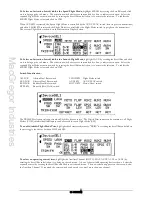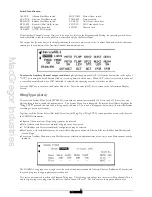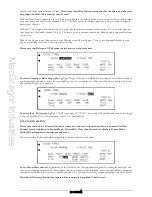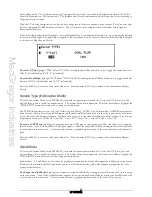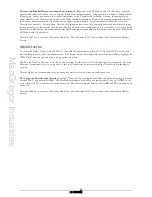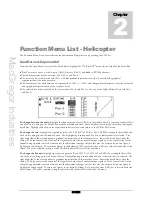
MacGregor Industries
4
BATTERY CHARGING
The polarity of all JR transmitter charge sockets is to have the centre pin connected to negative. This is different to many
other manufacturer’s chargers. Beware of incorrect connections based on colour coded wires.
We recommend that you
use only JR chargers with your JR system!
For peak battery capacity, the first charge should be for 22 – 24 hours. Thereafter, an overnight charge of 12 –14 hours will
bring the batteries to full charge.
Note that a diode is included in the charge circuit of the transmitter to prevent battery damage from incorrect chargers.
This also prevents the battery from being discharged through the charge socket and may prevent some "intelligent" battery
chargers from detecting the battery.
FUSE
The PCM9XII has a 3 amp internal fuse to protect the system in the event of a certain fault conditions. To replace the fuse,
remove the RF Module, NiCad battery and back cover screws (six screws). Remove the transmitter back, being careful not
to bend or damage the RF Module pins. The fuse is situated on the bottom left of the aerial PCB in the case back and
should only be replaced with a fuse of the same rating. Replace the back cover, making sure that the side cheek levers are
correctly located in the side cheeks and noting that the side cheek pads are mounted with the slot towards the case back.
Replace the RF Module and NiCad battery.
CHARGER
The charger supplied with your transmitter features two LEDs that light when the batteries are charged. If they do not light
when charging, make sure that both the transmitter and the receiver are turned off. During charging, the charger will rise in
temperature. This is normal and should not cause concern. If you have any worries about any of the charging equipment,
please seek expert advice. Please be sure to use the correct charge rate for your battery pack, any battery over 1000 mAH
should be charged at 120 mA.
SYSTEM CONTENTS
(subject to change)
1 x NET-229ES PCM9XII Transmitter
1 x R900 ABC&W Receiver
4 x NES-811 high performance Digital Servos (with accessories)
1 x 1100 mAH Receiver NiCad Battery
1 x Standard Switch Harness
1 x Heavy Duty Charger
1 x Pair 35 MHz Crystals (with orange flag and channel numbers)
1 x Accessory bag with Allen key and alternative Throttle Bar
INSTALLATION REQUIREMENTS
It is extremely important that your radio system is correctly installed in the model. Here are a few suggestions on the
installation of your JR equipment.
•
Wrap the receiver in protective foam rubber that is no less than 10mm thick. Secure the foam to the receiver with rubber
bands. This protects the receiver from vibration and in the event of a crash or a hard landing.
•
Mount the servos using the rubber grommets and brass bushes supplied. The brass bushes should be pushed into the
bottom of the rubber grommets, flange end towards the servo mount, after the grommets have been fitted to the servo.
When the servo screw is tightened securely, it provides the proper vibration isolation for the servo.
•
Make sure that the control linkages do not bind or impede the movement of any of the servo arms as they must be able
to move freely over their entire range of travel.
•
Mount all switches away from the engine exhaust and away from any high vibration areas. Make sure that the switch
operates freely and is able to operate over its full travel.
•
Mount the receiver aerial firmly to the model to ensure that it will not become entangled in the propeller or control
surfaces.
Summary of Contents for PCM9XII
Page 1: ...MacGregor Industries MACGREGOR INDUSTRIES Instruction Manual PCM9XII ...
Page 4: ...MacGregor Industries This page is intentionally blank ...
Page 43: ...MacGregor Industries 39 HELI ...
Page 65: ...MacGregor Industries 61 AERO ...
Page 85: ...MacGregor Industries 81 GLIDER ...
Page 86: ...MacGregor Industries This page is intentionally blank ...
Page 87: ...MacGregor Industries This page is intentionally blank ...

















